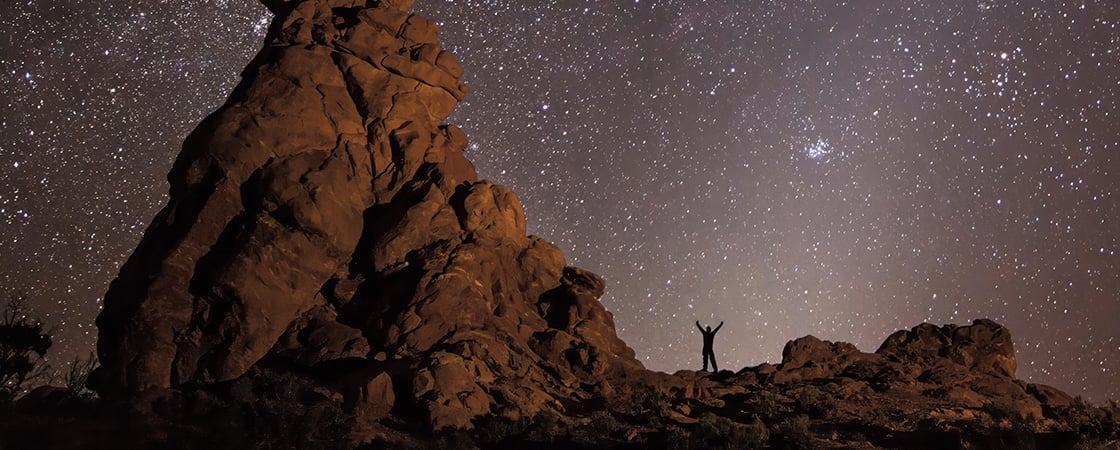Saving the Night Sky
The world is running out of dark places. But we can change that.
By Maggie Pierce

The world is running out of dark places. But we can change that.
Learning Objective: to understand how a writer uses rules of capitalization, then practice applying those rules in a paragraph
Saving the Night Sky
The world is running out of dark places. But we can change that.
By Maggie Pierce
NASA
This is what Earth looks like at night.
At 4:31 a.m. on January 17, 1994, residents of Los Angeles, California, were jolted awake by an earthquake. The quake knocked out the power, and all the lights in the city went out.
Yet stepping outside, residents weren’t greeted by total darkness. Looking up, they beheld a dazzling splash of stars. They also saw something alarming: an odd cloud looming in the sky. Some people called 911.
Turns out, that cloud wasn’t smoke or an alien spaceship. And it had nothing to do with the quake.
It was our galaxy, the Milky Way.
In Los Angeles, there was (and still is) so much artificial light—from streetlights, offices, stadiums—that it made most stars and planets impossible to see. As a result, many Angelenos had never seen the Milky Way.
Light Pollution
The brightening of the night sky is a result of something called light pollution: excessive use of artificial light. And Los Angeles is hardly the only city affected. Since the early 1990s, light pollution around the world has increased by at least 49 percent. Some 2,500 stars can be seen from Earth. But in most cities, only a few dozen are visible. In fact, the world is running out of dark places.
To be sure, there are advantages to lighting up the night. We can safely travel, study, and socialize long after the sun goes down. The presence of too much artificial light is causing problems, however. First, light pollution can disrupt our natural sleep cycles, which makes us tired and can negatively affect our health. Light pollution also confuses animals. Baby sea turtles, which hatch on beaches at night and use starlight shining on waves to guide them to the ocean, can lose their way in the presence of artificial light. Light pollution even harms plants, causing some trees to bloom too early or keep their leaves too long.
Keeping Skies Dark
Around the world, some cities have taken steps to decrease light pollution. In Hollywood, Florida, for example, beachfront homes are required to dim their lights at night to protect sea turtles.
Meanwhile, the International Dark-Sky Association (IDA) is working to keep night skies dark. It has certified more than 200 locations worldwide as “Dark Sky Places.” These places stay dark by using outdoor lighting only when needed and making sure bulbs are not too bright.
You can help reduce light pollution too. In fact, it’s as easy as flicking off lights when you’re not using them. You can also use light bulbs that give off warm-white or amber light, which don’t disrupt animals as much as the white or blue light that many bulbs produce.
Ashley Wilson of IDA says, “Light is a resource, just like water. We shouldn’t waste it.”
Write Like a Pro Challenge
Now take what you’ve learned about capitalization and apply it to your own writing. Imagine that you are a music critic and write a review of an album of your choice. (The album can be real or fictitious, from the past, present, or future.) Your review should include:
This article was originally published in the December 2023/January 2024 issue.
1. PREPARE TO READ (5 MINUTES)
Draw students’ attention to the directions in the upper left-hand corner of page 30 or at the top of the digital story page. Read the directions aloud.
2. READ AND DISCUSS (25 MINUTES)
Have students work independently or with a partner to follow the directions and complete the activity.
Optionally, before students complete the Write Like a Pro Challenge, give them some extra practice applying the rules in linked text in the article using the activity below.
3. WRITE (25 MINUTES)
Have students work in pairs or independently to take the Write Like a Pro Challenge on page 31 of the printed magazine or at the bottom of the digital story page:
Now take what you’ve learned about capitalization and apply it to your own writing. Imagine that you are a music critic and write a review of an album of your choice. (The album can be real or fictitious, from the past, present, or future.) Your review should include:
Project students’ reviews on your whiteboard to share the albums they wrote about and the words they capitalized. (Alternatively, have students exchange their reviews with a partner and check each other’s work.)
Distribute the Anchor Chart: Capitalization for students to keep as a handy reference in their notebooks.